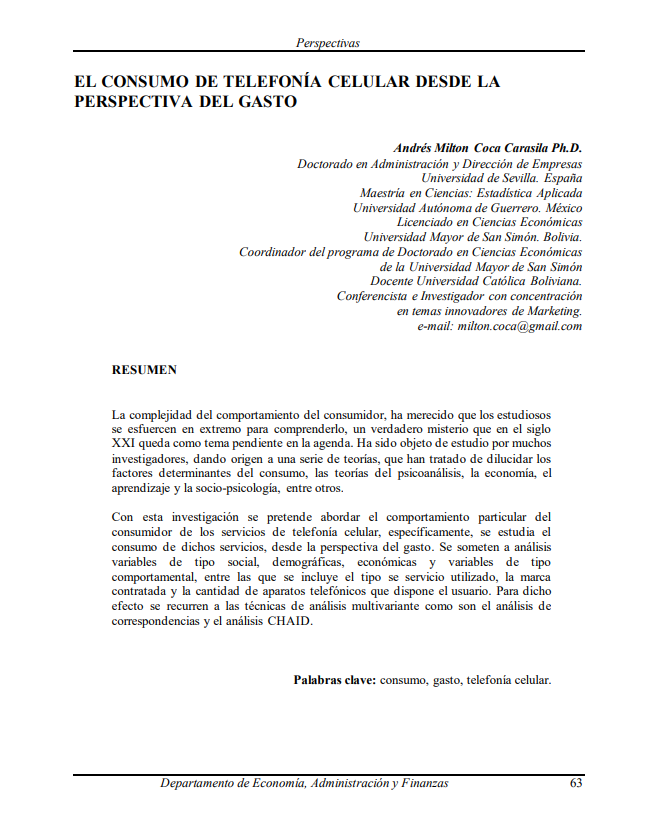Cell phone usage from the expenditure perspective.
DOI:
https://doi.org/10.35319/f6r62v34Keywords:
Consumer behavior, Consumption theories, Cellular phone servicesAbstract
The complexity of consumer behavior has led scholars to make great efforts to understand it—a true mystery that remains an unfinished topic on the agenda in the 21st century. It has been the subject of study by many researchers, giving rise to a series of theories aimed at clarifying the determining factors of consumption, including theories from psychoanalysis, economics, learning, and social psychology, among others.
This research aims to address the particular behavior of consumers of cellular phone services. Specifically, it studies the consumption of these services from the expenditure perspective. Social, demographic, economic, and behavioral variables are analyzed, including the type of service used, the contracted brand, and the number of phone devices the user owns. For this purpose, multivariate analysis techniques such as correspondence analysis and CHAID analysis are employed.
Downloads
References
Assael, H. (1999). Comportamiento del consumidor (6ª ed.). México: Thomson.
Belk, R.W. (1975). Situational variables and consumer behavior. Journal of Consumer Research, 2, pp. 157–164.
Blackwell, R.D., Miniard, P.W. & Engel, J.F. (2002). Comportamiento del consumidor. México: Thomson.
Cofetel (2007). Dirección de Información Estadística de Mercados. México: Cofetel.
Coll-Hurtado, A. & Córdoba, O.J. (2006). La globalización y el sector servicios en México. Investigaciones Geográficas, 61, pp. 114–131.
Cooper, D.R. & Schindler, P.S. (2006). Business research methods (9th ed.). New York: McGraw-Hill.
Dubois, B. (2004). Comprendre le consommateur (3ª ed.). París: Dalloz Sirey.
Greenacre, M. (2008). La práctica del análisis de correspondencias. España: Fundación BBV.
Hair, J.F., Anderson, R.E., Tatham, R.L. & Black, W.C. (2004). Análisis multivariante (5ª ed.). Madrid: Pearson Educación – Prentice Hall.
Härdle, W. & Simar, L. (2007). Applied multivariate statistical analysis (2th ed.). Berlin: Springer.
Kerlinger, F.N. & Lee, H.B. (2002). Investigación del comportamiento (4ª ed.). México: McGraw-Hill.
Kotler, P. & Keller, K.L. (2006). Dirección de marketing (12ª ed.). México: Pearson Educación.
Larraín, J.D. & Sachs, J.D. (2002). Macroeconomía en la economía global. México: Pearson Educación.
Levy, M.J.P. & Varela, M.J. (2005). Análisis multivariable para las ciencias sociales. Madrid: Pearson Educación – Prentice Hall.
Malhotra, N.K. (2004). Investigación de mercados: un enfoque aplicado (4ª ed.). México: Pearson Educación – Prentice Hall.
RAE (2008). Diccionario de la Real Academia Española. Extraído el 11 abril, 2008 de http://www.rae.es/.
Rivera, C.J., Arellano, C.R., Molero, A.V. & Martínez, T.M. (2000). Conducta del consumidor: estrategias y tácticas aplicadas al marketing (2ª ed.). Madrid: ESIC.
Sabino, C. (1991). Diccionario de economía y finanzas. Caracas: Panapo.
Santesmases, M.M. (2005). Dyane versión 3: diseño y análisis de encuestas en investigación social y de mercados. Madrid: Pirámide.
Schiffman, L.G. & Kanuk, L.L. (2007). Consumer behavior (9th ed.). New Jersey: Pearson – Prentice Hall.
Serra, M.M. (2005). Diccionario económico de nuestro tiempo. Eumed.net. Extraído el 11 abril, 2008 de http://www.eumed.net/cursecon/dic/dent/index.htm.
Smith, S.M. & Albaum, G.S. (2005). Fundamentals of marketing research. Thousand Oaks, Calif.: Sage.
Stanton, W.J., Etzel, M.J. & Walker, B.J. (2007). Fundamentos de marketing (14ª ed.). México: McGraw-Hill.
The World Bank (2001). Global economic prospects and the developing countries. Washington D.C.: The World Bank.
The World Bank (2006). Information and communications for development 2006. Global trends and policies. Washington D.C.: The World Bank.

Downloads
Published
Issue
Section
License
Copyright (c) 2010 Revista Perspectivas

This work is licensed under a Creative Commons Attribution-NonCommercial-ShareAlike 4.0 International License.
La Revista Perspectivas de la Universidad Católica Boliviana, es una revista de acceso abierto, por lo tanto, es de libre acceso en su integridad. Está permitida su lectura, búsqueda, descarga, distribución y reutilización legal en cualquier tipo de soporte únicamente para fines no comerciales, siempre y cuando la obra sea debidamente citada.




